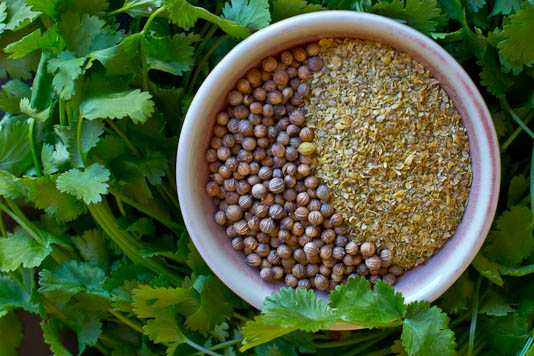
Short & Spicy are bite-sized descriptions of spices that make perfect morsels so perfect.
What: Coriander is a small plant from the parsley family. Native to parts of Europe, Middle East and Asia, it is one of the oldest spices. It derives its name from the ancient Greek word for bug, koris, due to the unpleasant smell of its unripe seeds and leaves. All parts of the plant are edible but the seeds and leaves are most commonly used in cooking. The seeds, often referred to as coriander or coriander seeds, are lightweight, ridged, greenish brown in color and look like peppercorns. The leaves, often referred to as coriander leaves, fresh coriander or cilantro, are deep green in color and look very similar to flat leaf parsley.
Taste & Smell: The seeds have a gentle warm, nutty and lemony flavor with a distinctive floral aroma. The leaves have a tasty subtle bitterness with citrus overtones and a strong herbaceous aroma. Delicious and widely used by many, it sometimes has an unpleasant soapy taste to some.
Main Use: Coriander seeds are used whole or coarse ground. The seeds are often fried in oil or dry roasted (directions below) to intensify their flavor and distinctive aroma. Ground coriander is often used with cumin and is a main ingredient in garam masala. It tastes great in stews, soups, curries, BBQ rubs and sausages. Coriander leaves are mainly used fresh and uncooked, and are often added as a garnish to a dish before serving. They taste great in almost anything but especially sauces, pestos, soups, curries and salads. Both are used widely in dishes from the Middle East, Europe, India, China, Spain, Africa, Latin America and Texas.
Other Uses: The seeds and leaves are considered to contain antioxidants and antibacterial properties. Health benefits include better digestion, lowered cholesterol, and relief with anxiety, insomnia and some skin infections. The leaves may assist in ridding the body of metals. In some parts of the world, a paste of coriander powder is used externally to help with muscle pain and arthritis.
Other Names: Chinese parsley (English), dhanyia (Hindi), kizbara (Arabic), pak chee (Thai), cilantro (Spanish), coriandre (French), nannambin/nannamzee (Burmese; leaves/seeds)
Story/Memory/Recipe: Read Spiced Latkes: From 0 to 60
Dry roasting method: Add the coriander seeds to a hot non-stick or cast iron pan. Do not use any oil. Heat till the seeds release an aroma and turn a slightly darker brown. Allow the seeds to cool down completely. Use whole or grind to a powder.
Kettle Confections says
I love this blog, I’ve always wanted to learn how to use all the different spices, you’ve assembled the perfect resource for that here!
Anjali says
Thank you! I’m so glad this was helpful. Stay tuned. I’m working on another Short & Spicy post that I think will be fun.